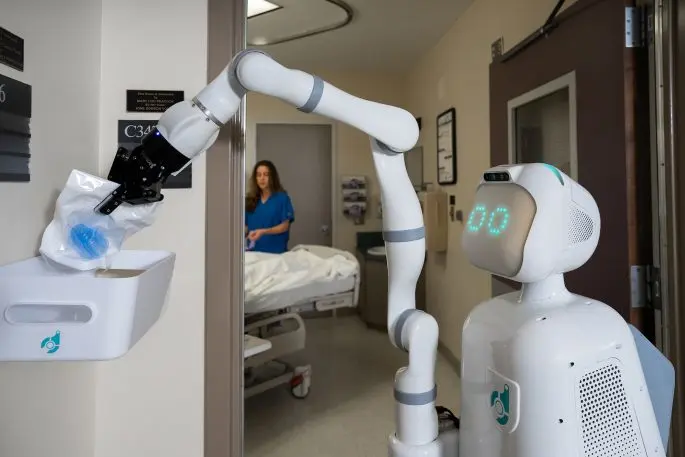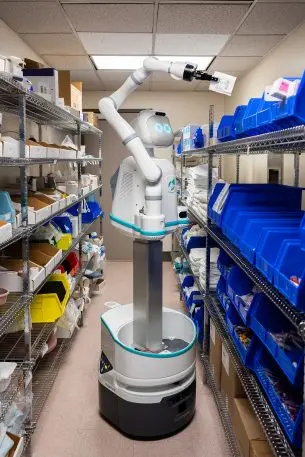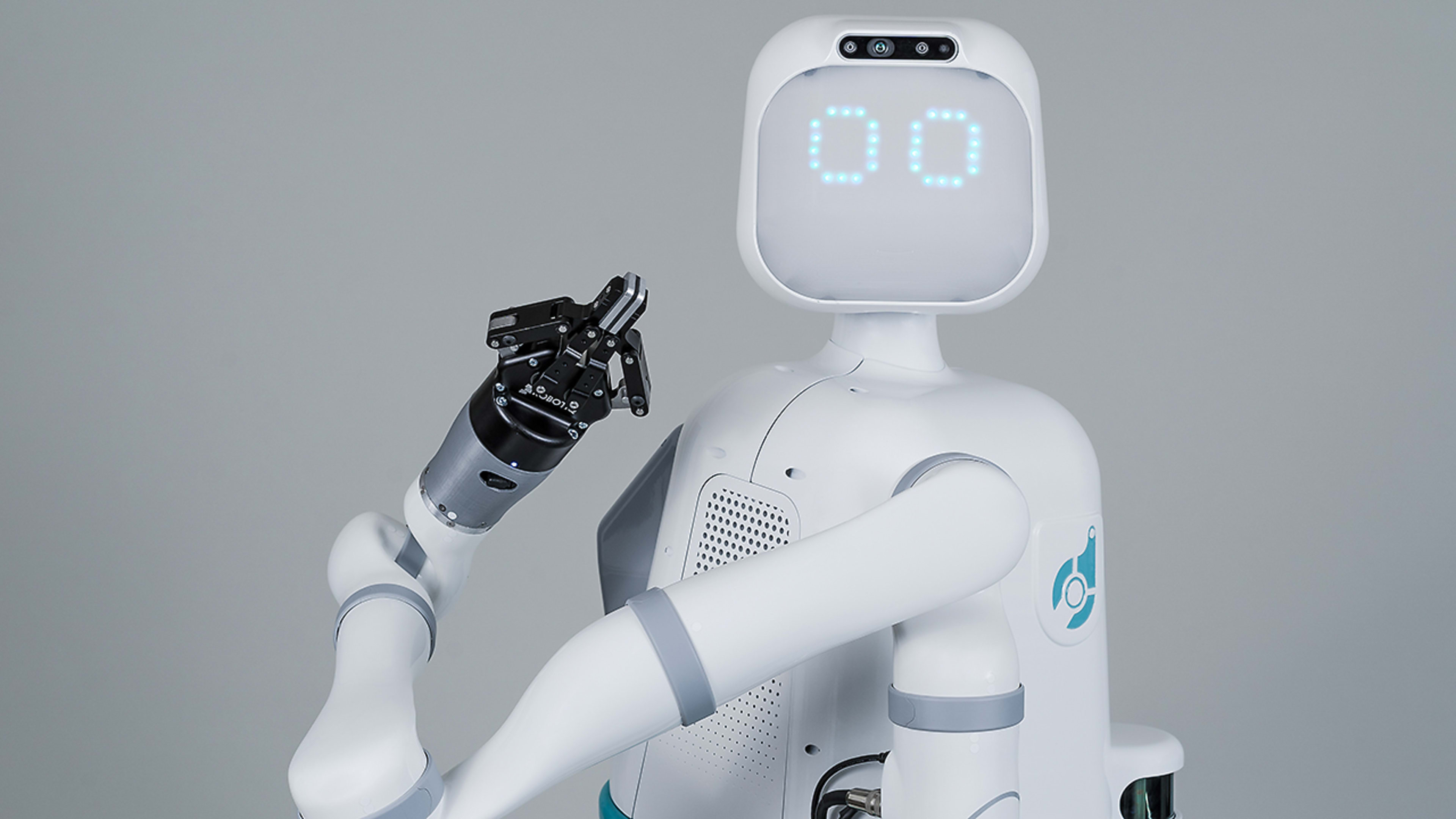Nurses are in high demand: The U.S. Bureau of Labor Statistics reports that the number of jobs for nurses will grow 15% from 2016 to 2026, which is much faster than other jobs. The current shortage has left hospitals in a crunch—and a few hospitals in Texas recently turned to an unusual solution: a robot named Moxi.
But Moxi, which was designed and built by the Austin-based company Diligent Robotics, isn’t trying to act like a nurse. Instead, Diligent Robotics founders Andrea Thomaz and Vivian Chu have designed their robot to run the approximately 30% of tasks nurses do that don’t involve interacting with patients, like running errands around the floor or dropping off specimens for analysis at a lab.
“We’re helping them augment their staff,” says Thomaz, who formerly was a robotics professor at UT Austin and Georgia Tech, where she ran the Socially Intelligent Machines Lab. “It’s hard to argue that we’re taking anyone’s job. Everyone is trying to make the nurses they have go further.”

Moxi is equipped with a robotic arm and a set of wheels on its base, and can be preprogrammed to run errands around the hospital. It works like this: Moxi is hooked into the hospital’s electronic health record system. Nurses can set up rules and tasks so that the robot gets a command for an errand when certain things change in a patient’s record on Moxi’s floor. For instance, if a patient has been discharged and their room is marked clean in the health record, Moxi will get a command to take an admission bucket—a set of fresh supplies for a new patient—to the room so that it’s all ready to go for the next person.
That means nurses don’t even have to remember certain tasks that used to be part of their daily job, which is a meaningful way to reduce their cognitive load. “They don’t have to think about telling the robot to do things,” says Chu, who has a PhD in robotics from Georgia Tech, where she worked in Thomaz’s lab.
Thomaz points to one nurse in Dallas who told the team that she never saw Moxi put admission buckets in clean rooms, but that the buckets were just always where they were supposed to be. The nurse told the Diligent team that she just didn’t have to think about the task anymore—which means that she could spend more time with patients. Learning what kinds of tasks would reduce nurses’ cognitive load took a lot of time: Before the team even started to build Moxi, they shadowed nurses and physicians for 150 hours to understand what they would need. Then, once the robot was built, the team’s engineers accompanied the robot everywhere during further tests at the hospital. Finally, the team was able to fine-tune Moxi’s interactions with nurses during beta trials at several hospitals in Texas during late 2018 and early 2019.
The preprogrammed nature of Moxi’s tasks doesn’t mean that the robot never interacts with people. Thomaz and Chu’s specialization when they were robotics researchers was in human-robot social interaction, and the robot is carefully designed to be nonthreatening and transparent in its actions. Its humanoid head only moves in directions that humans’ heads do, and its head and eyes always point in the direction it’s moving, a cue so that the people around it know where the robot is headed. It has a torso, a thin stand, and larger base, so that it wouldn’t look like a big intimidating “trash can robot,” as Thomaz put it.
“Our challenge was to find a balance between an arm that was functional enough to pick up enough things to be useful in the hospital but have a small enough form factor so [the robot is] not too bulky and scary,” she says.

While Moxi’s job is to take as many mundane tasks as possible off nurses’ plates so that they could spend more time interacting with patients, the Diligent team was surprised to find that patients were fascinated by the robot and wanted to interact with it during their beta trials. Patients ended up being so infatuated with Moxi that they would ask for selfies with the robot; one child even sent Diligent Robotics a letter asking where Moxi lived.
The robot was so popular that the Diligent team programmed superfluous activities for Moxi to do once an hour so that the robot would wander around the floor and flash heart eyes at people. “In between tasks Moxi would make a social lap to talk to her fans,” Thomaz says.
During the trials, Thomaz reports that the nurses and hospital staff had a similarly positive reaction—even from early skeptics. “Some nurses were like, ‘It creeps me out a little, I don’t like robots, I’m not into AI,'” Thomaz says. “But by the end they [were] like, ‘Hey Moxi, hey girl, how’s it going?’ It was dramatic, in a matter of two to three weeks.”
Thomaz and Chu launched Diligent Robotics in 2016 with a research grant from the National Science Foundation, and started building Moxi’s first version at the end of 2017. Now, with four, one-month beta programs complete at local hospitals, the team is planning to officially launch later this year in three or four hospitals.
Ultimately, the team wants to scale up to build human-friendly robots for other industries as well, though they’re focused on healthcare for the time being.
“Our real vision is bringing robots to markets that are working side by side with people, that are changing the future of work,” Thomaz says. “It’s going to enable people to do so much more.”
Of course, the threat of automation is a real one: Researchers project that robots will take 800 million global jobs by 2030. But if robots are built like Moxi, aiming to augment rather than replace human workers, the incoming automation revolution won’t necessarily be all bad.
“People can have so much more impact if 50% of your day is freed up to do more with your creativity and all of the things that you love about your job,” Thomaz says. “We think robot teammates are really going to be an interesting and huge step.”
Recognize your brand’s excellence by applying to this year’s Brands That Matter Awards before the early-rate deadline, May 3.
